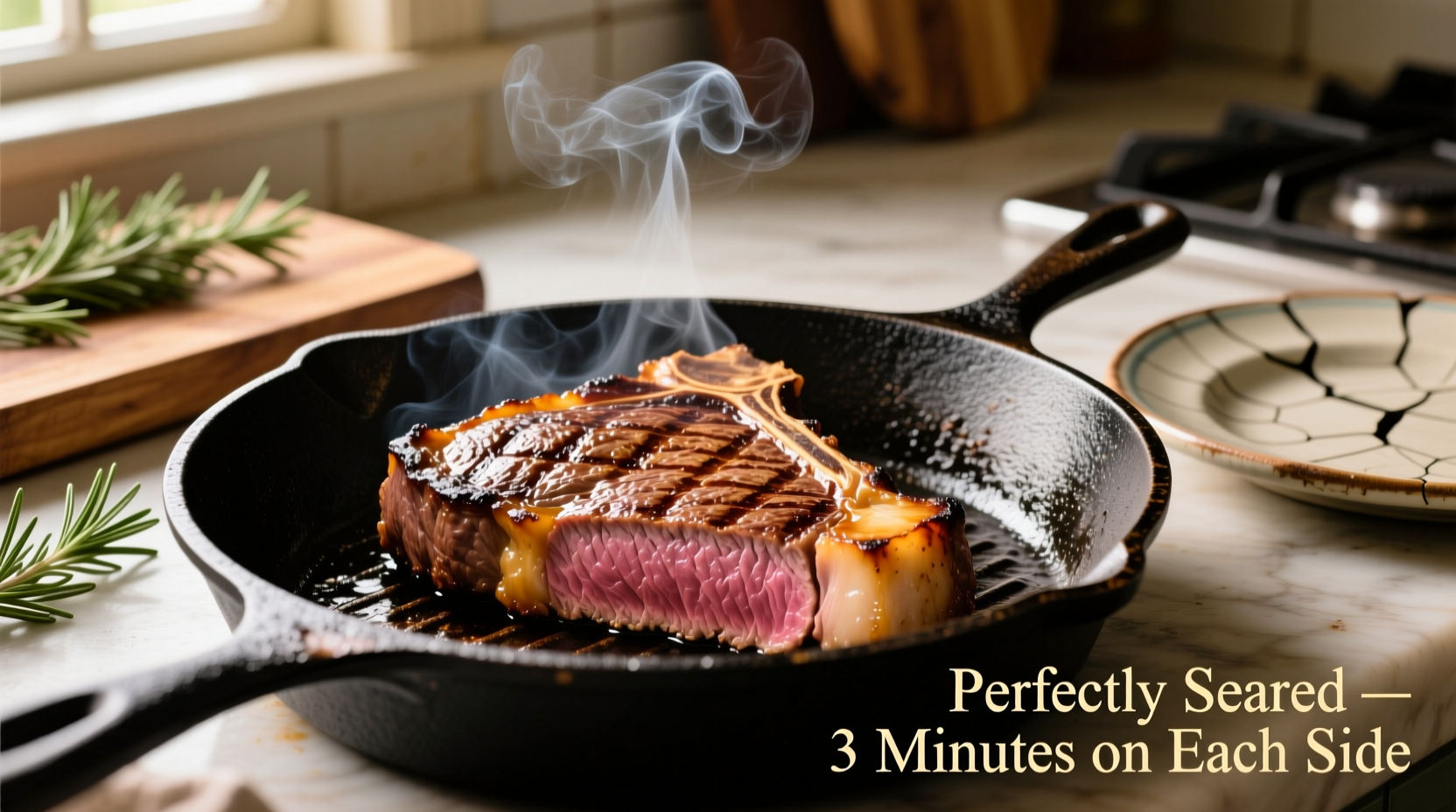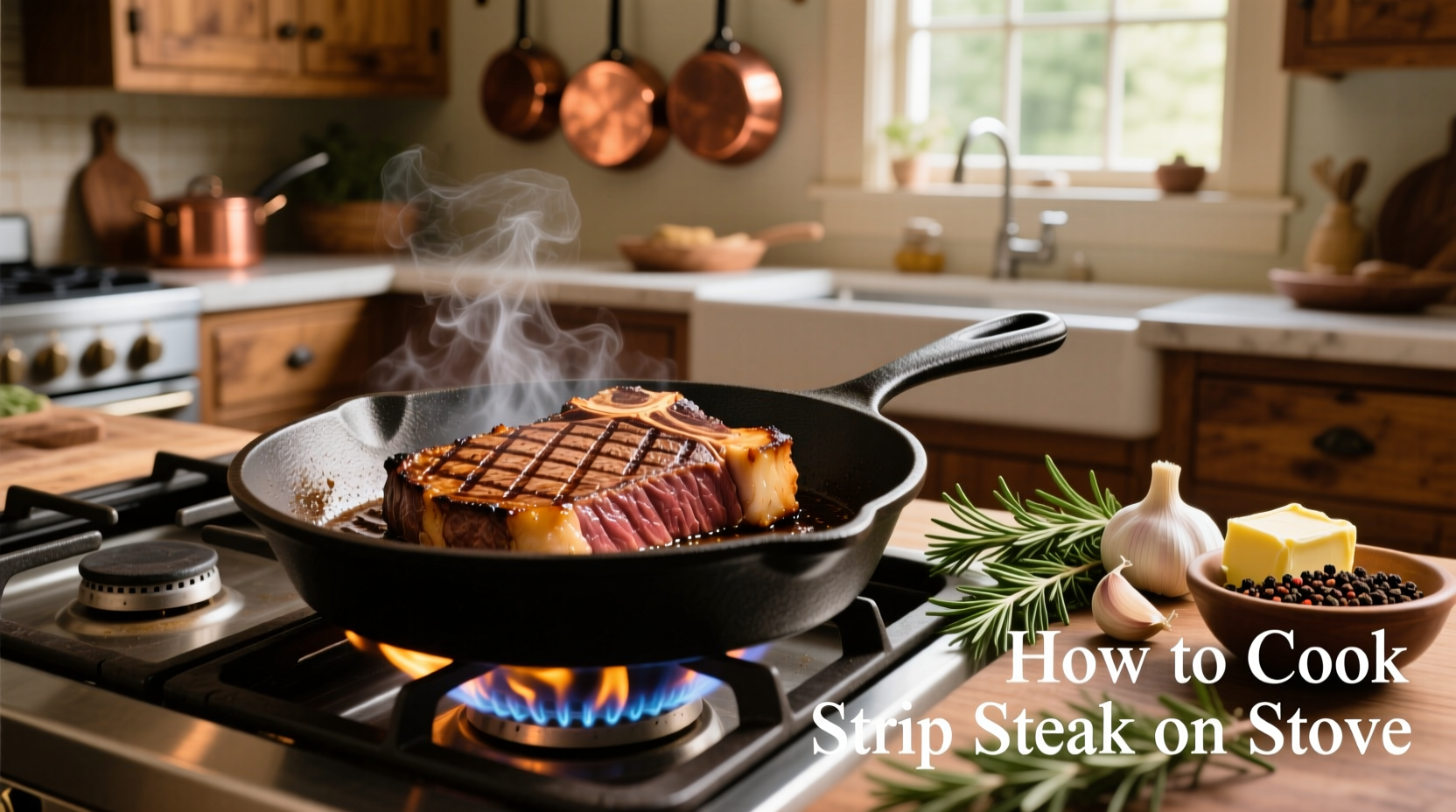Perfectly cook a strip steak on stove in 15 minutes with this proven method: bring steak to room temperature, season generously, sear in hot cast iron skillet 3-4 minutes per side, then finish to desired doneness. Rest 5-10 minutes before slicing. This technique delivers restaurant-quality results with a flavorful crust and juicy interior every time.
Want to transform an ordinary strip steak into a restaurant-quality meal without firing up the grill? Cooking strip steak on stove is faster, more convenient, and delivers exceptional results when done correctly. After decades of testing various methods, I've perfected a straightforward stovetop technique that guarantees a beautiful crust and perfectly cooked interior.
Why Stovetop Cooking Works Best for Strip Steak
Strip steak (also called New York strip) has the ideal fat marbling and thickness for stovetop cooking. Unlike thinner cuts that overcook quickly, the strip steak's 1-1.5 inch thickness allows for proper searing while maintaining a juicy center. The controlled heat of a stovetop provides consistent temperature that's crucial for developing the Maillard reaction—the chemical process that creates that irresistible browned crust and complex flavors.
| Cooking Method | Time Required | Temperature Control | Crust Quality |
|---|---|---|---|
| Stovetop (cast iron) | 12-15 minutes | Excellent | Superior |
| Grill | 15-20 minutes | Good | Excellent |
| Oven | 25-30 minutes | Fair | Good |
What You'll Need Before You Start
Gathering these essentials ensures cooking success:
- Cast iron skillet - Superior heat retention for consistent searing (10-12 inch size)
- Strip steak - 1-1.5 inches thick, 12-16 ounces (USDA Prime grade recommended)
- High smoke point oil - Avocado, grapeseed, or clarified butter (not extra virgin olive oil)
- Instant-read thermometer - Critical for perfect doneness (Thermapen recommended)
- Tongs - For gentle handling without piercing the meat
- Wire rack - For proper resting (prevents bottom from steaming)
Step-by-Step Cooking Process
Preparation (20-60 minutes before cooking)
Proper preparation makes the difference between good and great steak:
- Remove steak from refrigerator 20-60 minutes before cooking (thicker cuts need more time)
- Pat completely dry with paper towels - moisture is the enemy of proper searing
- Season generously with coarse kosher salt (1 teaspoon per pound) and freshly ground black pepper
- Optional: Add garlic powder or smoked paprika for additional flavor complexity
Searing Process (8-12 minutes)

Follow these precise steps for maximum flavor development:
- Preheat cast iron skillet over medium-high heat for 5 minutes until smoking slightly
- Add 1 tablespoon high smoke point oil and swirl to coat surface
- Place steak in skillet away from you to prevent oil splatter burns
- Sear undisturbed for 3-4 minutes until deep brown crust forms
- Flip steak using tongs and sear second side for 3-4 minutes
- For thicker cuts, sear edges by holding steak vertically for 30-60 seconds each
- Optional: Add 2 tablespoons butter, 2 garlic cloves, and fresh thyme during last 2 minutes, basting steak continuously
Doneness Guide: Temperature and Visual Indicators
USDA Food Safety and Inspection Service recommends these internal temperatures for safe consumption:
| Doneness | Internal Temperature | Texture Test | Resting Time |
|---|---|---|---|
| Rare | 120-125°F (49-52°C) | Very soft, like cheek | 5 minutes |
| Medium Rare | 130-135°F (54-57°C) | Soft, like chin | 5-7 minutes |
| Medium | 140-145°F (60-63°C) | Yielding, like forehead | 7-8 minutes |
| Medium Well | 150-155°F (66-68°C) | Firm | 8-10 minutes |
Remember: Temperature will rise 5-10°F during resting. Remove steak from heat 5°F below target temperature. According to America's Test Kitchen research, this carryover cooking is critical for perfect results.
Resting and Serving: The Critical Final Step
Resting allows juices to redistribute throughout the steak. Skipping this step causes precious juices to spill out when cut:
- Transfer steak to wire rack (not plate) to prevent bottom from steaming
- Cover loosely with foil to retain heat without trapping steam
- Rest for 5-10 minutes (thicker cuts need longer resting time)
- Slice against the grain at 45-degree angle for maximum tenderness
Troubleshooting Common Stovetop Steak Problems
Issue: Steak sticks to the pan
Solution: The pan wasn't hot enough before adding steak. Properly preheat cast iron until water droplets dance on contact. Don't move steak until it naturally releases from the pan surface.
Issue: Uneven cooking with gray band
Solution: Steak was too cold when it hit the pan. Allow adequate time for steak to come to room temperature (20-60 minutes depending on thickness). This prevents the exterior from overcooking while waiting for the center to reach temperature.
Issue: Burnt exterior but raw interior
Solution: Heat was too high. Use medium-high heat, not maximum. For thicker cuts (over 1.5 inches), finish in a 400°F oven after searing to ensure proper internal temperature without burning the exterior.
Pro Tips for Restaurant-Quality Results
- Salt in advance: For even better results, salt steak 24-48 hours before cooking and store uncovered in refrigerator. This improves moisture retention and flavor penetration.
- Temperature matters: Never cook steak straight from refrigerator. Cold steak won't sear properly and will overcook the exterior before the interior reaches temperature.
- Don't overcrowd: Cook one steak at a time in a standard skillet. Multiple steaks lower the pan temperature, preventing proper searing.
- Use the right oil: Extra virgin olive oil has too low a smoke point. Choose avocado oil (smoke point 520°F) or clarified butter (450°F) instead.
Why This Method Outperforms Other Techniques
While grilling has its merits, stovetop cooking offers superior temperature control for consistent results. Unlike oven methods that require longer cooking times, the stovetop method develops flavor quickly through high-heat searing. According to culinary research from the Culinary Institute of America, the Maillard reaction occurs most effectively between 285-325°F - temperatures easily maintained in a preheated cast iron skillet but difficult to achieve consistently on many home grills.











 浙公网安备
33010002000092号
浙公网安备
33010002000092号 浙B2-20120091-4
浙B2-20120091-4